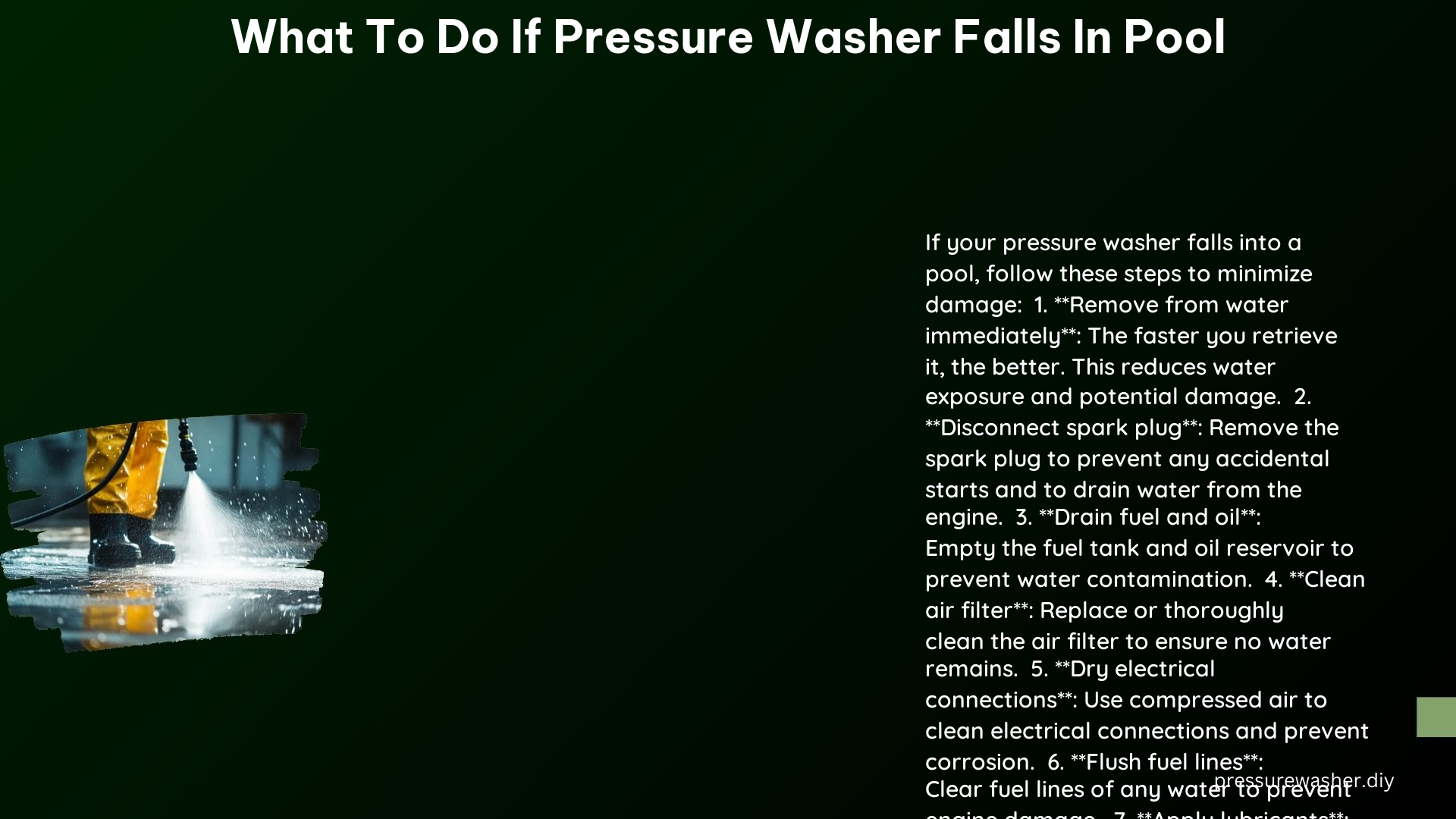If your pressure washer accidentally falls into a pool, it is crucial to act quickly to minimize damage and ensure the engine does not suffer from water exposure. This comprehensive guide will walk you through the necessary steps to recover your pressure washer and prevent long-term issues.
Immediate Action: Preventing Further Damage
-
Do Not Attempt to Start the Engine Immediately: Avoid the temptation to start the engine right after it has fallen into the pool. This can cause further damage, including hydrolocking the engine, which can be fatal. Hydrolocking occurs when water enters the engine’s cylinders, preventing the pistons from moving freely, and can lead to severe engine damage.
-
Remove the Spark Plug and Drain Water: The first step is to remove the spark plug, which will allow any water that has entered the engine to drain out. This helps prevent hydrolocking and reduces the risk of rust formation.
-
Use a spark plug wrench to carefully remove the spark plug, taking care not to damage the threads.
- Tilt the pressure washer to allow the water to drain out of the engine.
-
Ensure that all the water has been drained before proceeding to the next step.
-
Drain the Fuel and Oil: To prevent water from mixing with the fuel and causing corrosion, drain the fuel tank and carburetor. Additionally, drain the oil to prevent water contamination, which can lead to premature engine wear and failure.
-
Locate the fuel tank drain plug or valve and open it to allow the fuel to drain out.
- Remove the oil drain plug or use an oil extraction pump to remove the contaminated oil.
- Dispose of the drained fuel and oil properly, following local environmental regulations.
Cleaning and Drying the Components

-
Clean and Dry the Air Filter: The air filter is a critical component that can become saturated with water if the pressure washer falls into a pool. Remove the air filter and use compressed air to blow out any water or debris. Allow the air filter to dry completely before reinstalling it.
-
Clean Electrical Connections: Use compressed air to clean any electrical connections, such as the spark plug wire, ignition coil, and other wiring. This will help prevent corrosion and ensure proper electrical function.
-
Flush the Fuel Lines: Fuel lines can also become contaminated with water, so it’s essential to flush them out. Use a fuel line cleaner or compressed air to push any remaining water out of the fuel lines.
-
Dry the Carburetor: The carburetor is another component that can be affected by water exposure. Use a carburetor cleaner or compressed air to thoroughly dry the carburetor and its internal components.
Applying Protective Measures
-
Lubricate the Spark Plug Hole: To prevent rust from forming in the spark plug hole, spray a lubricant like WD-40 into the opening. This will help create a protective barrier against moisture.
-
Clean the Carburetor: In addition to drying the carburetor, use a carburetor cleaner to remove any residual water or debris. This will help ensure the carburetor is functioning properly.
-
Apply Rust Inhibitor: Consider using a rust inhibitor spray or lubricant on any exposed metal surfaces to prevent the formation of rust, which can lead to long-term damage.
Reassembly and Testing
-
Reassemble the Pressure Washer: Once all the components are clean and dry, reassemble the pressure washer. Replace the spark plug and refill the oil to the recommended level.
-
Test the Engine: After reassembly, pull the starter cord several times to ensure the engine is turning over smoothly. If the engine starts and runs without any issues, you can proceed to the next step.
Professional Repair or Replacement
- Consult a Professional: If the pressure washer does not start or runs poorly after following these steps, it may be best to consult a professional small engine repair technician. They can perform a more thorough inspection and determine if the engine can be salvaged or if replacement is necessary.
Preventative Measures
- Secure the Pressure Washer: To avoid such accidents in the future, ensure the pressure washer is securely positioned and anchored when in use, especially when working near water sources like pools. This will help prevent the pressure washer from accidentally falling into the water.
By following these comprehensive steps, you can increase the chances of recovering your pressure washer from a pool accident and prevent long-term damage to the engine and other critical components.
References:
– https://www.reddit.com/r/fixit/comments/1cessfu/this_just_fell_in_my_pool_is_it_finished/
– https://forums.jackssmallengines.com/Message/15569-Power-washer-fell-in-the-swimming-pool-YIKES/
– https://www.autogeekonline.net/forum/auto-detailing-101-a/54800-pressure-washer-fell-water-while-cleaning-boat.html
– https://www.houzz.com/discussions/1610193/pressure-washer-fell-in-pool
– https://www.hobbytalk.com/threads/pressure-washer-fell-in-pool.425514/
